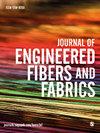碱处理对柳树皮纤维作为聚合物复合材料潜在填料性能的影响
IF 2.3
4区 工程技术
Q1 MATERIALS SCIENCE, TEXTILES
引用次数: 1
摘要
以柳皮为原料,提取柳皮纤维,用不同浓度、温度和时间的碱溶液对柳皮纤维进行改性。采用扫描电镜、傅里叶变换红外光谱、x射线粉末衍射仪和同步热分析仪分别对其形貌、表面官能团、晶体和热稳定性进行了研究。酸(H2SO4, 2 ml/l)提取法去除柳树皮中的半纤维素和部分木质素,清除了WB的聚集,保持了柳树纤维的晶体结构,显著增加了柳树纤维的晶体长度(从18.46 nm增加到30.15 nm),提高了起始降解温度(从262.23℃提高到297.62℃)和化学反应活性(DTG从0.57%/s提高到0.84%/s)。碱处理进一步脱除了柳纤维中的木质素,使纤维表面光滑,使纤维素(I 002)的强度从646次增加到1292次,晶体长度从30.15 nm延长到41.84 nm。不同碱处理条件下,结晶指数和热稳定性在处理温度为60℃,处理时间为7 h时达到最大值。处理后的柳木纤维在与高分子材料的复合以及作为添加剂在医药领域具有潜在的应用前景。本文章由计算机程序翻译,如有差异,请以英文原文为准。
Effects of alkali treatment on properties of willow bark fiber as potential fillers for polymer composites
In this work, willow fiber was extracted from willow inner bark and modified with alkali solution of various concentrations, temperature and time. The morphology, surface functional group, crystal and thermal stability were investigated by using a scanning electron microscopy, a Fourier transform infrared spectroscopy, an X-ray powder diffractometer, and a simultaneous thermal analyzer, respectively. The acid (H2SO4, 2 ml/l) extraction procedure removed the hemicellulose and part of lignin from willow bark, cleared the aggregation of WB, kept the crystal structure of willow fiber, dramatically increased the crystal length of fiber (from 18.46 to 30.15 nm), and enhanced the onset degradation temperature (from 262.23℃ to 297.62℃) and chemical reactivity (DTG: from 0.57%/s to 0.84%/s). The alkali treatment further removed lignin from willow fiber, smoothed the fiber surface, increased the intensity of cellulose ( I 002 ) from 646 counts to 1292 counts, and lengthened the crystal length from 30.15 to 41.84 nm. Varying the alkali treating condition, the crystal index and thermal stability reached to the climax at 60℃ of treating temperature and 7 h treating time. The treated willow fiber may have potential applications to composite with polymer, and to be used in pharmaceutical field as additives.
求助全文
通过发布文献求助,成功后即可免费获取论文全文。
去求助
来源期刊

Journal of Engineered Fibers and Fabrics
工程技术-材料科学:纺织
CiteScore
5.00
自引率
6.90%
发文量
41
审稿时长
4 months
期刊介绍:
Journal of Engineered Fibers and Fabrics is a peer-reviewed, open access journal which aims to facilitate the rapid and wide dissemination of research in the engineering of textiles, clothing and fiber based structures.
 求助内容:
求助内容: 应助结果提醒方式:
应助结果提醒方式:


